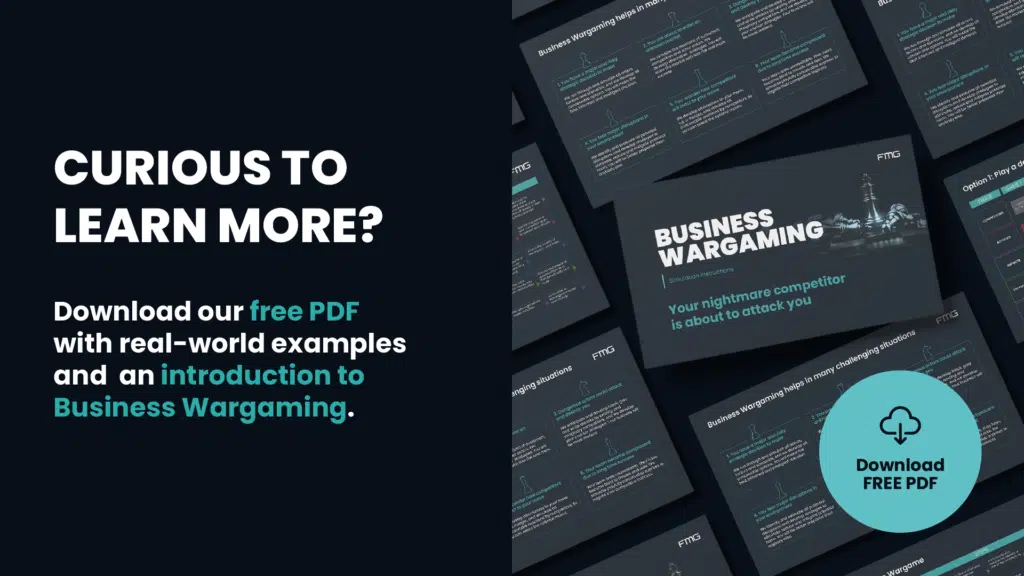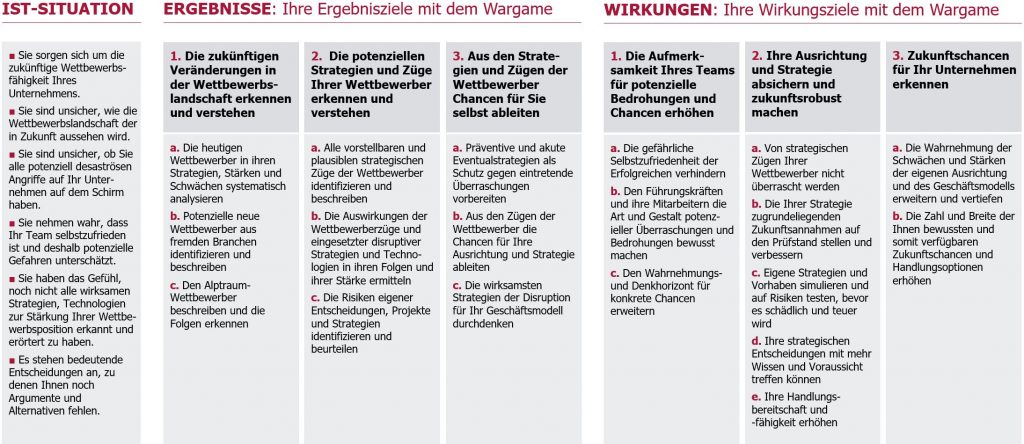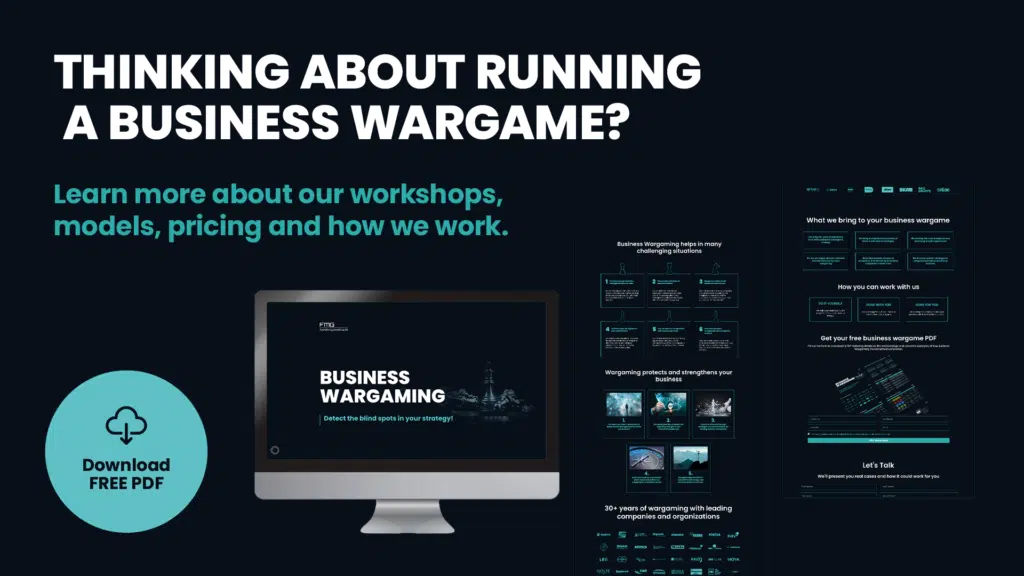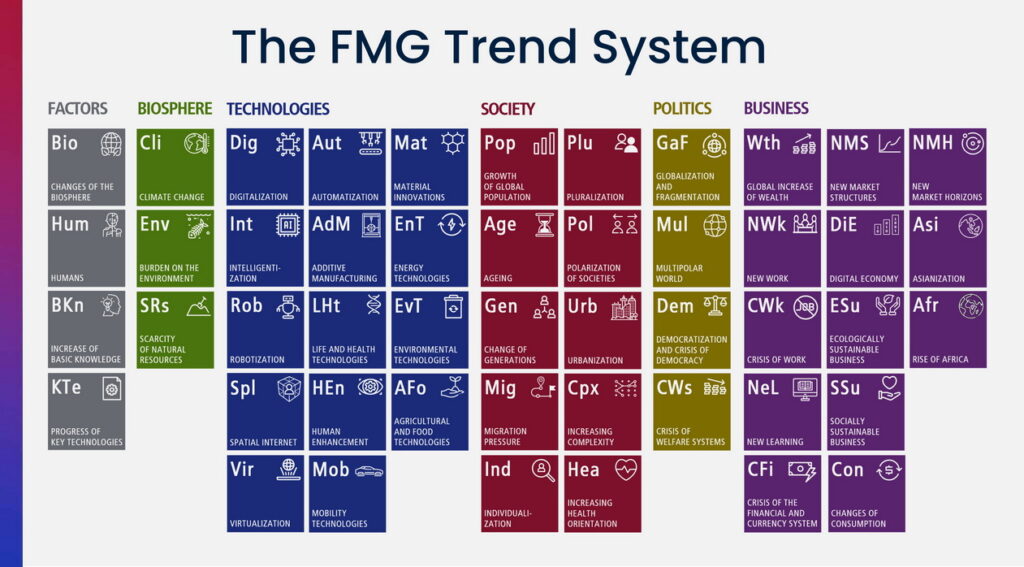Identify your blind spots and opportunities for your future with a business wargame!
Lacking the really good ideas on how to make your business great and future-proof again? Play a Business Wargame!
- Are you leading a company, a business unit or a team?
- Are you concerned about the future viability of your business?
- Are you worried about the future?
In all these cases, a business wargame can help you better understand threats and see the opportunities in them.
The principle of wargame
A very exciting and thrilling experience. I want to give you a guide for your business wargame here. With my team from FutureManagementGroup, I have conducted countless exciting wargames over the past 20 years.
A wargame is a workshop to simulate conceivable, probable and also surprising attacks by competitors against your company and learn from them where the blind spots in your strategy are, where you are vulnerable, but also where your best future opportunities lie.
A business wargame is a role-playing game, but don’t invite your colleagues to a role-playing game. If you call it a wargame, they are more inclined to come and join in. You can also use other common terms, such as “be the enemy” or “nightmare competitor” or “disrupt me”. And let me say in advance: I am a peaceful person and do not propagate aggression or even wars here. It’s just a harmless but very inspiring thought experiment in the field of economics.

Battle of Dorking
In 1872 there was an attack by the German Empire on Great Britain. It was a year after the victory of the North German Confederation led by the Prussian army over France. And one year after the founding of the German Empire on 01 January 1871. The Germans were in the midst of a strong industrialization and were also enormously motivated by the victory over France and by the founding of the Reich. The British Navy was destroyed by so-called “fatal engines”. Today they are called torpedoes. The German army landed in Sussex. Both the British Navy and Army were scattered all over the world to expand and maintain the Commonwealth. In addition, much of Britain had demilitarized and trained poorly. So they were weak at home.

The attack was decidedly surprising. Surprising because there was no obvious reason for the attack, no dispute, no conflict, no crisis.
It came as it had to come. In the decisive battle of Dorking, the Germans were victorious over the British. The Germans conquered Britain and made it a highly taxed province of the German Empire. Great Britain had to hand over its role as the leading naval power as well as the huge Commonwealth to the German Empire.
But wait: the whole thing never happened. It was a made-up story. Scenario. Written by George Chesney in 1871, a year before the alleged attack. Published in this book: The Battle of Dorking. When William came. Wilhelm, the Emperor of the German Empire.

The book was printed and read hundreds of thousands of times and caused an enormous stir and hot and fearful discussions. As a consequence, the British strengthened their armies and navy again with high time pressure and enormous investments. And they established the Secret Service. In this way, by inventing a previously unthought-of but plausible and frightening scenario of an attack by a strong adversary, the scenario may have been prevented from becoming reality. These reflections can be considered as one of the first documented wargames.
Goals of a Business Wargame
The purpose of a wargame is to help you imagine what competitors might do and how they might do it to take away your orders and your customers. To drive your company into irrelevance and bankruptcy. And how they could use the latest amazing technologies to do that and use the smartest strategies to make you disappear from the market.
But a business wargame is only meant to deliberately scare in the first part, to wake up a team that may be too complacent. But fear without hope is harmful.
The second goal is for you to preventively protect yourself from these attacks by being able to prepare for them. This is how you make your alignment and strategy more future-robust. This is exactly why many authorities and companies simulate attacks on their infrastructure. In order to be able to identify and remedy the weak points.
And the third and most important goal is that by turning around potential competitor attacks, you accurately identify your greatest future opportunities. And please use them only by fair and legal means and for the benefit of your customers. And please don’t do it by directly harming your competitors. This will make your company and business model much more future-robust, and you will never again run the risk of missing key threats and opportunities through lack of attention.
Through a business wargame, you calibrate your team’s attention to signals in the marketplace. This gives you a kind of strategic radar of the future, and it’s practically free.

How to proceed in the Business Wargame
You can run a business wargame quite pragmatically in three hours, but also very professionally in two or three days with several rounds.
1. determine the business field
In doing so, you can take your current company and business model as the subject of the attacks. Or, if you have a vision for your future company and business model, you can take that as an object of attack as well. This is a wonderful way to test whether your alignment is future-proof.
Determine what effects customers will pay your company for. So don’t focus on the tangible products and services, focus on what your customers are really buying. In other words, not on the car, but on mobility, pleasure and prestige, and not on health insurance, but on the feeling of security as a desired effect.
2. determine the competitors
Select real, potential and even imaginary competitors. Take competitors that you respect, that you despise, that already exist or that don’t yet exist. Make sure you always take a rich, intelligent and aggressive Chinese as a competitor as well. And if it’s not there yet, rest assured, it’s coming.
And add Alphabet as a competitor, which is Google’s parent, so you can think about the totally digital disruptions as well. In any case, you need to bring into play the nightmare competitors, the nightmare competitors.
3. put yourself in the role of your competitors
Put two, three or more employees in the role of a competitor, depending on the size of the overall group
Provide teams with thinking tools, such as a list of innovative technologies that are emerging in your industry. Or a visualization of the elements of your business model.
You can also simulate in one round of the wargame that there is a new crash followed by an economic crisis triggered by a collapse of the euro banking system, which is not entirely unlikely.
4. let the competitors attack your company
Then these competitor teams attack your company and business model. With the knowledge of your business model. You’ll be surprised at the mean things your employees come up with. This allows you to simulate what could happen in the near or distant future.
You simulate the attacks you are actually afraid of. However, you will only get rid of these fears about the future and the feeling of threat if you face them, deal with them and make provisions for the eventuality.
5. determine the impact of the attacks
Now switch roles. Your teams now become teams of your company again.
Leave one employee from each competitor team in that role. He or she now presents the team with the attacks that the competitor team has selected as the most effective, i.e. the most dangerous and damaging to you. Now you can see what impact the attacks are having on your company’s success factors. Where you are vulnerable. You can see where the impacts would be and how bad the impact of the attacks would be.
The teams then assess and decide what can be neglected and what absolutely must be taken care of.
6. develop contingency strategies
In the next step, develop so-called contingency strategies.
These are preventive strategies, measures that you can implement today. Either to prevent competitors from attacking in the first place, for example through patent protection or better contracts with your customers, or measures to minimize the consequences of an attack.
7. develop your opportunities
Your competitors’ attacks – if you turn them around – are exactly the opportunities you need for the future. After carefully evaluating and selecting all your opportunities, you will have a clear picture of the business areas, business models and strategies that will sustain your company’s existence in three, five or ten years.
You recognize and exploit your opportunities in the market of the future. In this way, you will get rid of your fears about the future and see the future as less threatening and more full of opportunities. By simulating, analyzing and reversing future possible attacks, your strategic alignment is future-proof. What doesn’t kill you makes you stronger.
I wish you a bright future!
Have a bright future!

It is best to set a date for your wargame right away.
If you have any questions about the methodology, the necessary tools or the organization, I will be happy to answer them. Email me: PM@futuremanagementgroup.com
P


































